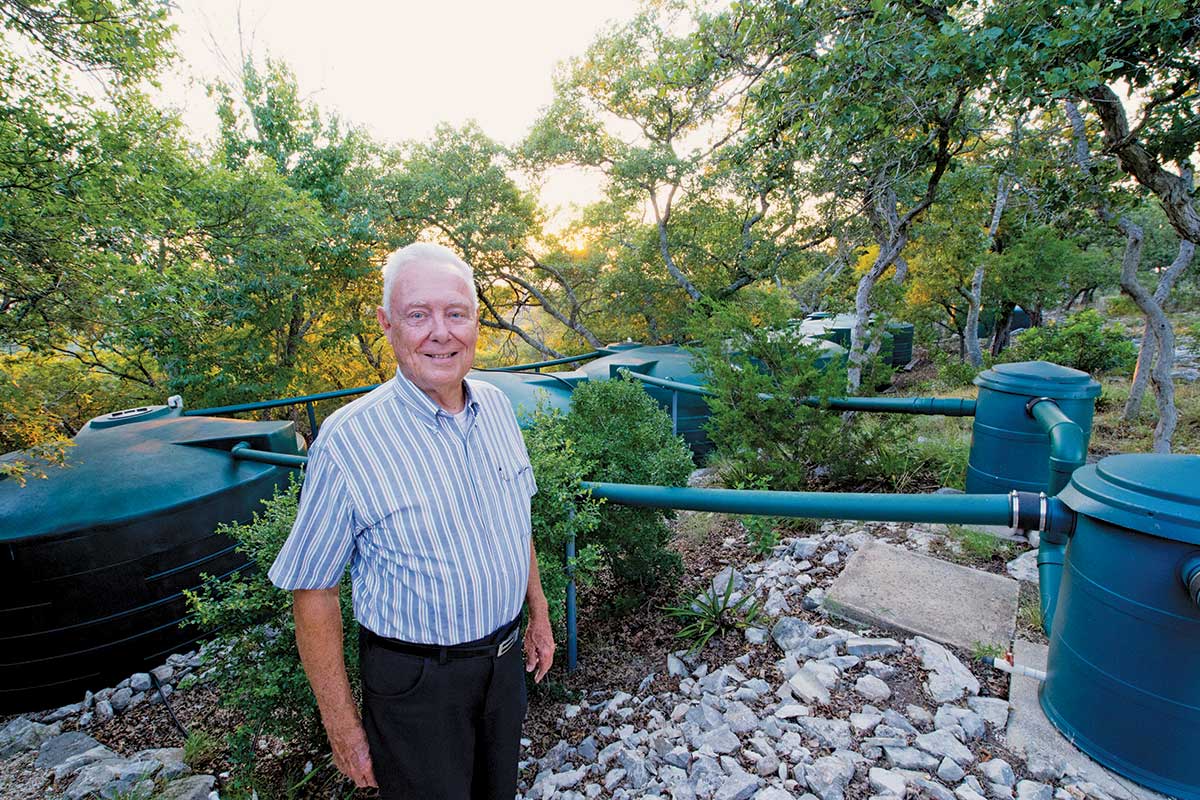Hard-packed, fractured stretches of bone-dry earth and pale, cloudless skies with months of unrelenting heat isn’t exactly an appropriate backdrop for a conversation about rainwater harvesting.
Or is it?
Sanjeev Kalaswad, rainwater harvesting coordinator with the Texas Water Development Board and a leading proponent of rainwater harvesting in the state, thinks it’s just the right context for enlightening Texans about collecting and storing rainwater. The severity of ongoing drought in some parts of the state pits us in a stare-down with our worst fears: What if we run out of water?
Kalaswad offers a bit of consolation: “Even during a drought we get some rain,” he says. And even if it’s less than an inch, or if it’s a weak drizzle, a surprising amount of water can be collected with the right system, he says.
No matter when you decide to install a rainwater collection system, it’s a pretty safe bet that over time you will reap the benefits.
Although the size and complexity of collection systems run the gamut between a few barrels connected to a downspout, and massive, multi-thousand-gallon concrete tanks fed with a network of pipes, the basic principle is the same: Use the roof of your house or some other building to channel rainwater into a main artery hooked to a cistern, or water storage vessel.
For anyone interested in installing a simple rain barrel and downspout, you can probably pull it off with a friend to hold the ladder. For those less handy, you’ll likely need assistance with larger systems.
Under average conditions, it’s possible to harvest 620 gallons of rainwater for every inch of rain that falls on a 1,000-square-foot roof. In a 2006 report to the Texas Legislature, the Texas Rainwater Harvesting Evaluation Committee stated, “Approximately 38 billion gallons of water would be conserved annually if 10 percent of the roof area in Texas could be used for rainwater harvesting.”
Water Never Tasted So Good
John Kight is a retired civil engineer living in Boerne with his wife, Mary Evelyn. When the couple, members of Bandera Electric Cooperative, started construction on their Hill Country home in 2000, they decided to install a rainwater collection system to support their total water needs, from a kitchen faucet to an outdoor sprinkler. “It would have cost $26,000 to dig a well, and the water had sulfur and iron in it and was very hard,” Kight said. “It tasted bad.”
He did the numbers. For $14,500, he could build a 30,000-gallon rainwater harvesting system that would sustain the couple through scant rainfall, using the 1950s drought of record as a standard.
Kight’s rainwater collection system has been operating since 2001 and has not run dry, even during the punishing, record-setting drought of 2011. In the meantime, Kight has become a rainwater-harvesting evangelist. For the past several years, he has been conducting regular workshops on the subject at the Cibolo Nature Center in Boerne, and has seen participation grow from a handful to 70 attendees each month. He helped lobby the Legislature to allow local taxing authorities to exempt all or part of the assessed value of property used for rainwater conservation systems, provide sales tax exemptions for rainwater harvesting equipment and materials, and prevent homeowners’ associations from banning rainwater harvesting systems.
Admittedly, Kight is not your average rainwater harvester. The engineer in him knows every pipe and filter, every detail of the construction, the material composition, the hydraulic science, the biological environment and the precise measurement of what goes in and what goes out of his 11 forest-green, polypropylene water tanks every day.
At the height of the 2011 drought in August, Kight had recorded one-hundredth of an inch of rainfall, with 21,150 gallons of water left in the 40,500-gallon capacity system. (Kight added five tanks after 2001.) In that same month, he and Mary Evelyn used an average of 44 gallons of potable and 42 gallons of nonpotable water per day. Kight likes to point out that the average national water use is 60 gallons per person daily, but rainwater harvesters typically use only 35 gallons a day per person.
Rainwater, free of the minerals usually present in groundwater, cuts down on housekeeping, too. There’s no calcium buildup around the tub or the kitchen sink. The dishwasher doesn’t get clogged with mineral deposits, the coffeemaker doesn’t need a vinegar bath, and you can pour plain tap water into the steam iron.
But there’s something else that’s even better. Kight dips his hand into the refrigerator’s icemaker and presents a palm full of small, crystal-clear ice cubes. He puts them in a sparkling glass and fills it with tap water. It’s pure and cool, like liquid satin on the tongue. Water never tasted so good.
‘We’ll Still Have Water’
In drought-prone West Texas, Nathan Mulder and his wife, Kathy, members of Lighthouse Electric Cooperative in Floyd County, northeast of Lubbock, have been collecting rainwater for 14 years. At a cost of about $10,000, which included a 3,000-square-foot metal roof, Mulder installed his own system of eight tanks with a total capacity of 14,000 gallons.
The rainwater is used to supplement well water and water that is periodically trucked in for irrigation, Mulder says, although he hasn’t hauled any water for 1 1/2 years. At one time, his 160-foot well got down to 4 feet of water due to heavy irrigation use. But with the rainwater system diverting some water to the well, it has been replenished to 40 feet.
“During the 2011 drought, we used about 50 percent well water, and the rainwater tanks were half full,” Mulder says. No small thing, considering there was no rainfall for a year, save for one 6-inch downpour. By April of this year, all the tanks were full.
Even with full tanks and water again available from the well, the Mulders are conservative with their water use. “We don’t waste water. Even if the well goes out, we’ll still have water,” Mulder says.

